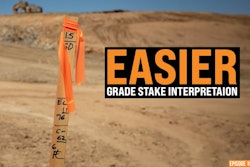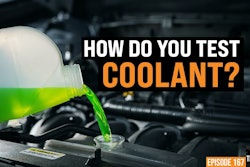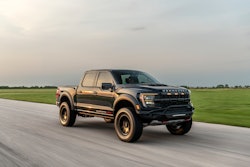When it comes to machine control in the U.S., Leica Geosystems may not be the first name that comes to mind.
But the company has been making inroads on the construction site over the past 10 years, with not only its equipment automation offerings but with other technology as it focuses on the entire jobsite.
On this week’s episode of The Dirt, Leica VP Troy Dahlin discusses the company’s machine control and other tech and how it differentiates itself from the competition. It has established partnerships with the industry’s major manufacturers, including Cat and Deere. But it also operates as an open system that is compatible with any equipment brand.
Beyond machine control, Leica Geosystems has integrated safety devices that can be worn by workers on the ground and link to machines to prevent accidents, ground penetrating radar to detect underground utilities and collision-avoidance systems, to name a few.
So to find out more about Leica Goesystems and its many construction solutions, check out the latest episode of The Dirt.
Equipment World serves up weekly videos on the latest in construction equipment, work trucks and pickup trucks – everything contractors need to get their work done. Subscribe and visit us at equipmentworld.com!
In This Episode:
- 00:00 - Intro: Leica Geosystems
- 00:31 - Why is Leica Not as Popular in the US for Machine Control?
- 02:23 - Leica’s OEM Collaborations
- 03:44 - What Sets Leica Apart From its Competitors?
- 06:56 - How Does Machine Control Play into Leica’s Larger Product Portfolio?
- 10:53 - Leica Products: Ground Penetrating Radar
- 11:23 - Leica Products: Collision Avoidance
- 12:58 - Leica Products: Reality Capture
- 13:18 - Leica Products: Jobsite Surveillance
- 13:48 - How All These Products Fit into the Bigger Picture
- 17:28 - Final Thoughts
Bryan Furnace (00:00):
Today we're here to talk to one of the biggest names, if not the biggest name in the machine control world, and yet we don't really hear about them a lot here in the US. Today we're talking with Leica, and Troy is going to break down what Leica does, what their product offering is, and why we don't know the name quite as much as some of the competitors in the industry.
(00:36):
So my first question is the one that I think a lot of people in the industry wonder. You know the big names of Topcon and Trimble in the industry, but globally, Leica is actually way bigger than either of those companies. Why is it here in the US, Leica doesn't feel like it's as prevalent as the other two?
Troy Dahlin (00:58):
I think it really goes back to... So Leica has a really long history in the survey and geospatial communities well over a hundred years and have been present in the market, in the US and Canada markets, serving the survey industry. So there's a really long history there and a reason why we're well known in that space.
(01:20):
I think it's important to realize that our journey in construction is a much more recent development for our company. It's more around the 10 years that we've had the iCON and the MC1 products that we've been really in construction. So what we've been able to do is leverage the relationships with the survey community and translate that over into some equity in construction.
(01:48):
So it's been, like I said, a shorter journey, but being able to use that history and the reputation around excellence in positioning and data quality has really translated over. And so it's given us an opportunity to win over customers. And then really most importantly of that is as we take care of them, we gain their advocacy in the market as well and build our brand reputation. So we just really started later in the market, but we've been growing the business very, very quickly.
Bryan Furnace (02:23):
I will say, it's always occurred to me that when you partner up with names like Caterpillar and John Deere, you get a cheat code in life to marketing, whoever's partnering up with them. And I do feel like that's happened with some of the other brand names is just by default because they've partnered with those strong marketing names, they just naturally have their name thrown around much more frequently.
Troy Dahlin (02:47):
Sure. I think that's very true, and I think it's also important to remember that there's different styles of partnering with those OEMs as well. And so with some you maybe pursue just a collaboration, whereas some it's more of an integration, so there's definitely some subtleties within that as well.
Bryan Furnace (03:08):
Yeah. On that note, what are some of the OEM partnerships that Leica has been able to form or is currently forming, and where can customers start to see the Leica systems?
Troy Dahlin (03:20):
We do have partnerships with some of the folks that you mentioned, like John Deere and Caterpillar. We've also had a long-standing relationship with Case New Holland, JCB, SANY, Liebherr, and then we also have more in the roading business. We have a strong long-standing partnership with OEMs, like AMACO.
Bryan Furnace (03:43):
Oh, okay. So what would you say is one of your biggest differentiators between some of the other competitors? Where do you guys really shine, and specifically here, not on the survey side, really in my mind, this conversation's more about the machine control side? What really differentiates you guys?
Troy Dahlin (04:01):
Sure. I think there's differentiation within machine control and then there's differentiation within heavy construction technologies. And I see the machine control as a part of heavy construction technologies, but I think the question being about machine control, there's a couple really key differentiators for us. Number one is that we are an open architecture company. That's a part of our strategy. So we understand that customers in general do not run exclusively one brand of machine, even one brand of pickup.
(04:38):
So we also want to make sure that if they do have product that they owned previously from one of our competitors, we want to make sure that we don't make using those things inaccessible to them by taking on our products as well. So we really pride ourselves on making sure that we have an open architecture strategy where they can actually have a mixed fleet of technologies on a site.
(05:06):
Of course, our hope and our ambition in this is to provide them the best products, the best service, and then over time as they're replacing that fleet, they're certainly a little more biased towards our product. So I think that's one.
(05:23):
I think another one is just some of the developments where within machine control, where we're incorporating some of our other technologies around safety awareness and a partnership with Xwatch, for example, where some intelligence can be built into a design to prevent an excavator, for example, from swinging into a building or hitting the utility. So creating avoidance zones where we'll just hydraulically lock out the machine, not just on digging underneath them, but raising the boom, swinging all of those things, even the travel motors on the tracks to stop them from creating damage on a project site.
(06:09):
So I think there's some really interesting blending of the technologies of on-machine and off-machine that help really set us apart with respect, just specifically machine control.
Bryan Furnace (06:22):
So two things that I take away from that. First is it is unbelievably refreshing to have a company come at this from the angle of, we're not trying to put you into our ecosystem, lock you into our ecosystem and by default push every other brand out. As a consumer that's so nice that I have the freedom and flexibility to work with my existing fleet, or going forward, choose what I'm going to do without having to be locked into something. So I do really appreciate that aspect of what you guys do.
(06:53):
The other thing I had is, can you expound a little bit more on your initial statement of you think about the machine control as being a part of the broader heavy civil picture. What exactly do you mean by that and what are you guys offering that plays into that?
Troy Dahlin (09:12):
Yeah. So having been a contractor myself and raised in the industry, in the field, when I think about a project that you're awarded, a contractor is going to be paid by the cubic yard, by the ton, by the square yard or square meter, by the linear foot on a project. I've yet to see a contract where the contractor was paid to machine control. I mean, machine control is a tool to gain efficiency for the contractor, for the worker.
(09:44):
And so there's always an ambition for the contractor to complete a project that's on time, it's on spec, it's on budget, and at the end of each night, we set all of our people home safe to their family and to their friends. I mean, that's what we hope and pray for every night. So when we think about that machine control is a super valuable asset, it's a super valuable tool to leverage for the machines that it's on, or for the person that's holding a rover.
(10:18):
But then when we think about, well, that's not everybody that contributes on a heavy construction site. So if you think about, how does everyone on that site have a contribution towards on spec, on budget, on time and bringing people home safely? It presents this opportunity for us to really provide this broader basket of solutions that helping each one of the tasks, whether it's underground utilities masquerading, it really doesn't matter.
(10:50):
So we have some solutions like ground penetrating radar, so allowing you to go in and without digging and potholing every single connection, but with precision map what is underground, so you can include that in your model. So you're going to not only save time, not having to pothole every utility crossing, but you're also going to not have the downtime and the expense associated with utility strikes if you're aware that that's there and how to locate.
(11:23):
Then back on our safety awareness, we have some really cool wearable technologies for the people on the ground and a system in the machines that will make sure that it's alerting both the operator and the person on the ground as proximity gets closer and closer to prevent people from just inadvertently walking into the path of a machine. And it does that through some audible, very loud, actually beeping, some haptics, so it's vibrating and light flashing. And for the operator, there's the ability to actually see the orientation of the person to the machine.
Bryan Furnace (12:00):
Oh, wow.
Troy Dahlin (12:01):
If I'm on an excavator and it's behind me to my left, I can see that on the screen and I understand now the distance that person or asset is. To go with that we have, on a lot of construction sites, you've got graders and scrapers that are traversing the site maybe at higher speeds or pickups. So we have collision avoidance solutions that are tracking assets as they're moving. And if they're moving in a path where there's a collision detected, it will alert them to the hazard and the orientation, again, of where that threat could be from. And so the faster they're moving the further back they get that notice. So those are some really nice solutions that help prevent downtime, extra repair costs, the costs associated with having someone injured and out of work and these things.
(12:57):
We have a whole suite of reality capture products, so being able to use LiDAR on a site, whether it's fixed or whether it's flying. So that's a nice option that we provide as well. So a lot of people are starting to move the whole BEM world into the civil world, so BEM to SIM transition. And then we also have some really interesting offerings as well. So a part of the Hexagon portfolio is a company called OxBlue, and OxBlue does job site surveillance. So cameras that can be set up on site that will monitor. And there's a lot of intelligence built into the software to detect different types of assets that helps prevent theft, can allow someone to check on progress.
(13:47):
So I think when you start to look at all of those different technologies, everything from an injured worker to a theft on a site, damages the contractor's ability to bring that project in on budget and on time at least. Machine control certainly helps with keeping things on spec and on time. And one of the things that we've always heard in the industry over the last few years is that, "Gosh, it seems like more operators are retiring from the industry than entering." So now people have always been, but even more for the contractor now hiring people and maintaining them, keeping them healthy is vital. So they're one of our most precious resources to just being able to continue in our businesses. So with these increased solutions, we can help keep them safe.
(14:41):
We can also keep the field people in the field, not in the office. We can keep the office people in the office and not in the field. And generally that's a good thing because most productive in their native environment. And at the end of the day when people are feeling productive, they're feeling safe, they're feeling like they're contributing to this greater cause, it's just a big benefit to their mental health, their even willingness to stay in the industry longer. So I think there's a lot of very obvious benefits, and then there are a whole lot of these intangibles that are huge that technology can help provide.
Bryan Furnace (15:25):
I will say through all of what you just went through, it does occur to me, it feels a little bit now that while competitors have been playing loud checkers, you guys have been in the background playing quiet, chess. Everything you just laid out, it's way more in depth than any of the other solutions that seem to be out there, and I do think it's because of your surveying background and history. You guys are far more encompassing than it sounds like the competitor's products are.
(15:58):
So it's really interesting now, because I didn't realize there was this whole product suite that came along behind the big... And let's be honest, in the industry right now, the big show pony item is machine control, and you guys have all of these supporting products behind it that I think the large majority of us are unaware of.
Troy Dahlin (16:17):
Yeah, thank you for saying that. I think we're very proud of, we want to build high quality products, everybody does. More importantly, we have to build solutions. So a single product can provide some level of value. When you start to put a solution together, it increases the value. When you put a series of solutions and can actually link them together you create an environment. And once you create the environment, it really helps almost drive a culture within the contractor as well.
(16:56):
And we know that products are great, but support is everything. If you have the latest and greatest Ferrari, but you can't get it to start, it's going to be fairly frustrating. So we want to make sure that we back up the quality of our products with the high quality of service through ourselves and our partners as well.
Bryan Furnace (17:20):
Yeah. Well, Troy, thank you so much for all of this information and breaking down the Leica ecosystem for us. I really appreciate it.
(17:28):
Well, thank you again for Troy and Leica taking time to come on the show and really break out their product suite for us. As you can see, there are a ton of solutions and a ton of product offerings that Leica has that we just aren't as familiar with as operators on the front line. As always, I hope this helps you and your business. We'll catch you on the next episode of The Dirt.










